Rhodobryum roseum is an attractive moss that grows primarily on thin soils over rocks in woodlands. The upper leaves form a crowded rossette that becomes erect and rather contorted when dry. Sporophytes are rarely produced.
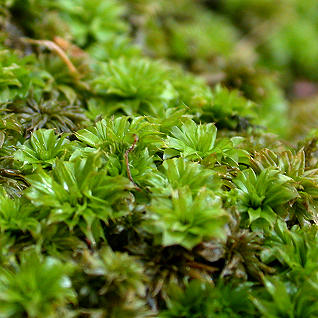
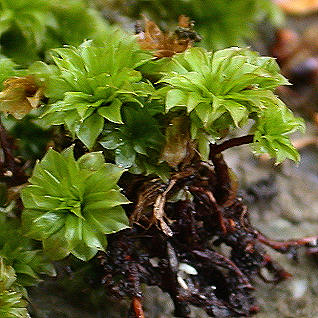
Rhodobryum roseum is an attractive moss that grows primarily on thin soils over rocks in woodlands. The upper leaves form a crowded rossette that becomes erect and rather contorted when dry. Sporophytes are rarely produced.


With Christmas just a few days away I figured it would be a good time to discuss some of the plants often associated with the holiday. Besides trees, probably the one that most often comes to mind is the poinsettia (Euphorbia pulcherrima). The poinsettia is native to Mexico and South America. It is a member of the spurge family (Euphorbiaceae), many members of which produce milky latex sap and showy bracts (modified leaves) that surround one or more floral structures called cyanthia. A cyanthium is composed of a single female flower partially surrounded by a cup-like involucre topped by five simplified male flowers. In the poinsettia the cyanthia are yellow-green and the floral bracts resemble the leaves but are large and scarlet red.
A long-standing myth is that the poinsettia is poisonous due to the death of a 2 year old child in 1919 that was falsely attributed to ingestion of this plant. While the plant is not considered edible, the toxicity of the plant is quite low and at worst it may cause upset stomach or vomiting if eaten.
Another popular plant this time of year is the Christmas Cactus, which is actually represented by a few species mostly in the genus Schlumbergera. In the wild they are epiphytic cacti, growing on trees in forests of South America. What appear to be leaves are actually flattened stems. Sections of the stem root easily in a loose potting mix that includes a good proportion of sand. Flowering is triggered by short days and long nights, as is the case with poinsettia. While I don’t have any pictures of the latter, I did manage to find a few pictures of a Christmas Cactus in bloom.

Christmas Cactus
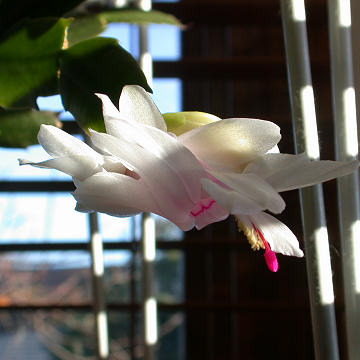
I will end this with a perhaps less commonly known plant associated with the holiday, and one that is native to Eastern North America. The Christmas Fern (Polystichum acrostichoides) is so named because it was once popular for use in Christmas decorations due to its tough, evergreen leaves that can be found throughout the year, even under snow. It grows on well-drained soils in rich, shady woodlands.
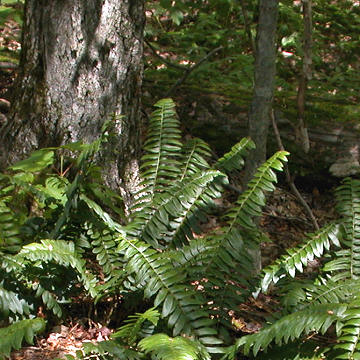
Christmas Fern
There are two species of ‘beech ferns’ that occur in eastern North America. They have traditionally been placed in the genus Thelypteris and this how I treat them here. However, recent evidence suggests inclusion of these ferns in a segregate genus (Phegopteris) instead.
In Broad Beech Fern (Thelypteris hexagonoptera) the lowest pair of pinnae (leaflets) are longer than the second pair. In addition, the rachis is herbaceous-winged throughout. This species forms colonies in moist or dry woodlands.
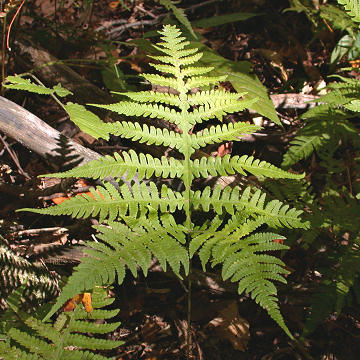
Broad Beech Fern
In Long Beech Fern (Thelypteris phegopteris) the lowest pair of pinnae are shorter than the second pair and the rachis is no herbaceous-winged between the lower two pairs of pinnae. The fronds also tend to be narrower than those of Broad Beech Fern. This species prefers rocky stream-side habitats and is common along waterways in the Adirondacks of NY.

Long Beech Fern
Climacium dendroides, or Tree Moss, is one of the largest mosses found in North America. Often found in dense stands, it is also one of the most attractive mosses when wet.
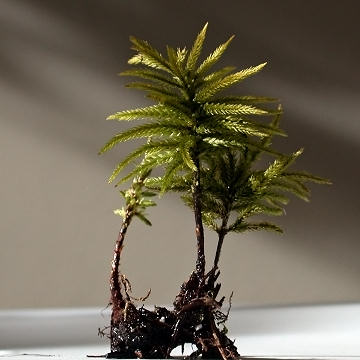
I recently added an index of seedless plants to the database of plants on Plants of the Northeastern U.S. This is intended to make it easier to find pages related to ferns, horsetails, clubmosses, mosses, and liverworts. There are still quite a few mosses to be added, including Bryum argenteum (below).
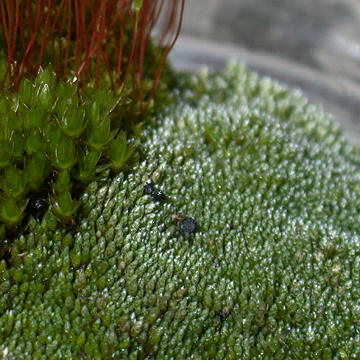
This species is easily identified as it grows in very short, dense colonies and has a silvery overall appearance. It is common in dry, open areas like driveways and sidewalks.
This is a closeup of a moss shoot tip bearing a slash cup filled with antheridia (male reproductive structures). The function of the splash cup is to use the momentum of rain drops to disperse the sperm contained within the antheridia.

And here is a closeup of the interior of the splash cup.
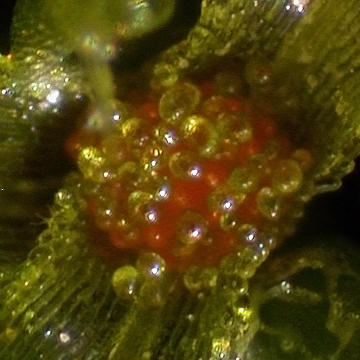
I recently updated the images on the page for Conocephalum conicum (Scented Liverwort), primarily to add an image of the sporophyte. They look like really small mushrooms, and the dark, round spots at the base of the ‘cap’ are the sporangia. Meiosis takes place in the sporangia and they eventually release spores.
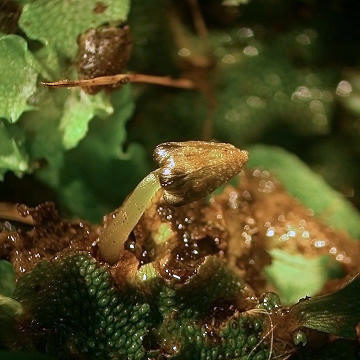
Bryophytes, which include mosses, are known as non-vascular plants. Although mosses lack the vascular tissues xylem and phloem, many mosses posses water-conducting cells called hydroids and food-conducting cells called leptoids. Unlike the xylem of vascular plants, the hydroids found in mosses are not lignified.
Many mosses have leaves only a single cell-layer thick. A clear exception can be seen in a leaf of a Polytrichum sp. As seen in this image, the only parts of the leaf that are a one cell layer thick are the very edges. The midrib, or costa, of the moss leaf is seen in the center of this cross section towards the bottom.
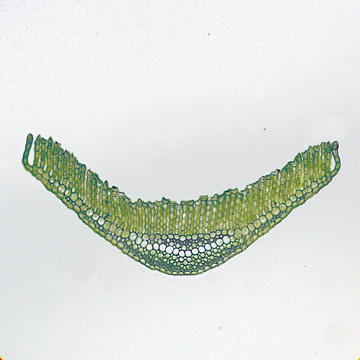
The thick layer of cells on the top of the leaf are called lamellae. They are like ridges that run parallel to each other over the length of the leaf and are several cell layers long and tall and a single cell wide. The lamellae are filled with chloroplasts and increase the effective area for photosynthesis to take place.
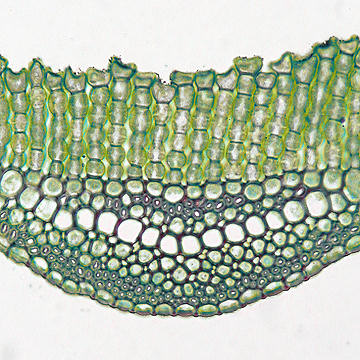
Taking a closer look at the costa, we can see the water conducting hydroids that are visible as the larger row of cells near the middle. These have large, empty spaces inside to provide ample space for water to flow. The cells above and below are the food-conducting leptoids and the surrounding cells with the thickened cell walls are called stereids. The stereids have a supportive function in the leaf.
In the future I plan to write an article on the life cycle of a moss similar to the one I did recently for a fern.
I snapped some pictures of various fern structures the other day and figured that I would do a little photo gallery showing the various stages of the fern life cycle. Unlike animals, the diploid stage (the one with two sets of chromosomes) in plants does not produce gametes. Rather, this stage produces spores via meiosis and is therefore known as the sporophyte (spore-producing plant). The sporophyte is the stage most familar to us, as seen in the following image.

The fern sporophyte produces leaves called fronds. On the back of the fronds of many species are often found little dots called sori (singular is sorus). To the naked eye they look like little brown spots like the ones below.
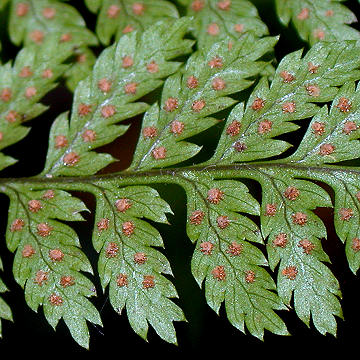
Even at this magnification the actual structure of a sorus is not clear. Zooming in a little further the surface begins to look a little rough.

The reason for the rough appearance is the presence of the sporangia that make up the sori. The sporangia are not always visible because in some ferns they are covered by a structure called an indusium. In this particular species there are no indusia, so if the sori are viewed under a dissecting microscope and viewed at 3X magnification the sporangia become clearly visible.

One of my students described the appearance of the sporangia as bug-like. This is due to the row of large cells circling the outside of a sporangium. This is called the annulus and can be clearly seen if a few sporangia are scraped from the back of the frond and mounted with some water on a slide. The following image shows a sporangium viewed at 40X magnification.

Everything seen up until now has been part of the sporophyte and would be diploid. Inside the sporangium is where meiosis takes place, and this process results in the production of haploid spores from diploid cells. The spores are greenish or brown with a warty surface and several can be found within each sporangium. The annulus on the outside of the sporangium shrinks or expands with changes in moisture in the environment and helps control opening and closing of the sporangium. Under the right conditions the sporangium will open and release spores into the air. The image below shows several spores that were mounted on a slide and viewed at 400X magnification.

These spores can drift through the air until moist conditions set in, and then the spores will take on water and become heavier, at which point they will settle to the ground. If the environment is suitable the spores will germinate and develop into the haploid life stage known as the gametophyte. This progression from one life stage to another is known as alternation of generations and occurs in all plants. The fern gameotophyte is known as a prothallus and is often heart-shaped and green. They can vary in size but in some species may be up to a cm across. The following is an image of a fern prothallus viewed at 40X magnification after being stained and mounted on a slide.

The little dots covering the surface of the prothallus are antheridia. Each antheridium is filled with sperm, the product of mitosis within those cells. Under moist conditions these sperm will be released to seek out eggs to fertilize. Eggs are sometimes produced on the same prothallus as the sperm, but in some species may occur on a seperate prothallus. Eggs are produced in specialized structures known as archegonia. Each prothallus can produce a single zygote that will develop into a new sporophyte. The zygote and subsequent sporophyte are diploid because they are the product of fertilization – the union of two haploid gametes (n + n = 2n). The developing sporophyte will appear as a short stem with a single leaf (shown at about 4X magnification as viewed under a dissecting microscope).

The sporophyte will be dependent on the gametophyte for a short time, after which the gametophyte will die and the sporophyte will become independent and develop into what we recognize as the adult fern.

Notice that no seeds are produced at any point in the life cycle. Ferns are known as seedless vascular plants because they have a free-living gametophyte and rely on spores for dispersal. The gametophyte is retained within the ovule of seeds plants (the ovule is what develops into the seed). Since ferns do not produce seeds, this makes growing them a bit more challenging, as it requires first sowing the spores and waiting for the gametophytes to develop, then providing a film of water in order for fertilization to occur. After that the process is similar to the handling of seedlings, although the young ferns may require a more humid environment until they mature.
Powered by WordPress